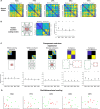This is a preprint.
Cognitive maps for hierarchical spaces in the human brain
- PMID: 39974987
- PMCID: PMC11838598
- DOI: 10.1101/2025.02.05.636580
Cognitive maps for hierarchical spaces in the human brain
Abstract
Many of the environments that we navigate through every day are hierarchically organized-they consist of spaces nested within other spaces. How do our mind/brains represent such environments? To address this question, we familiarized participants with a virtual environment consisting of a building within a courtyard, with objects distributed throughout the courtyard and building interior. We then scanned them with fMRI while they performed a memory task that required them to think about spatial relationships within and across the subspaces. Behavioral responses were less accurate and response times were longer on trials requiring integration across the subspaces compared to trials not requiring integration. fMRI response differences between integration and non-integration trials were observed in scene-responsive and medial temporal lobe brain regions, which were correlated the behavioral integration effects in retrosplenial complex, occipital place area, and hippocampus. Multivoxel pattern analyses provided additional evidence for representations in these brain regions that reflected the hierarchical organization of the environment. These results indicate that people form cognitive maps of nested spaces by dividing them into subspaces and using an active cognitive process to integrate the subspaces. Similar mechanisms might be used to support hierarchical coding in memory more broadly.
Keywords: fMRI; hippocampus; occipital place area; retrosplenial complex; spatial integration; spatial memory; virtual reality.
Conflict of interest statement
Conflicts of interest The authors declare no conflicts of interest.
Figures









References
Publication types
Grants and funding
LinkOut - more resources
Full Text Sources
